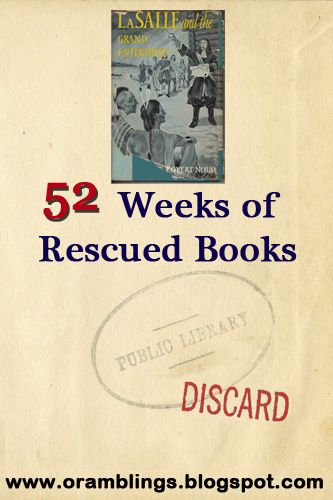 So did you guess the French Explorer also with ties to the Mississippi River from last week’s post (if not just look at the title of this post). Of course, LaSalle wasn’t his name – that was Robert Cavalier. Funny how he’s remembered for part of his title “sieur de La Salle” which basically means “lord of the La Salle [estate].” The name was the only part of his inheritance he was able to keep when he renounced his worldly goods to enter the priesthood.
So did you guess the French Explorer also with ties to the Mississippi River from last week’s post (if not just look at the title of this post). Of course, LaSalle wasn’t his name – that was Robert Cavalier. Funny how he’s remembered for part of his title “sieur de La Salle” which basically means “lord of the La Salle [estate].” The name was the only part of his inheritance he was able to keep when he renounced his worldly goods to enter the priesthood. LaSalle and the Grand Enterprise
Nolan, Jeannette Covert. New York: Julian Messner, 1951. Print 178 pp.He left the Jesuit school before taking his vows to join his brother in Canada, free to explore and build settlements by his own free will and resources rather than constantly under orders from the church. Of course, he’d renounced most of the resources that would have been available to him and had to live on a small allowance from his family. That was unfortunately the theme of LaSalle’s life: great vision but reliance on others to pursue it.
He ran into problems with the constantly changing authorities in New France. The ship he had built with borrowed funds sank on its way back home laden with furs for repayment. There is even rumor that the Jesuit priesthood tried to sabotage his expeditions by rallying native tribes against him. In the end, LaSalle was murdered by a member of his own expedition.
LaSalle’s two main journeys took him down the Ohio River and then down the Illinois River to the Mississippi River. In between he would have to venture back to Quebec and Paris to secure authorization and funding. It was on his third voyage –seeking the mouth of the Mississippi in the Gulf of Mexico, that he overshot his target and landed on the coast of Texas. Trying to travel over land back to the mighty river, he was killed and denied the decency of a burial. Most of his loyal friends, family and crew were also killed.
This book paints a much darker picture of life in the New World than The Explorations of Pere Marquette. There are political power plays going on between the Church and the Government and the various sects of priests (Marquette had been a Jesuit, but LaSalle’s brother was a Sulpician). This may be a more accurate picture of the times than last week’s book, but it also demands an older audience. The end of the book with the betrayal and murder is intense if not explicitly gory.
According to Who Should We Then Read? Vol. 2 (a great resource for bibliophiles) the author, Jeannette Nolan (1897-1979) wrote an award-winning poem when she was only nine. She was editor of her school paper and yearbook and as an adult she wrote for several magazines. Her focus seems to be on biographies for teen readers with subjects as diverse as Stephen A. Douglas to Aaron Burr to James Whitcomb Riley.
I was thrilled to find this book. Years ago when we moved to the state, I discovered a treasure—A Guide to Studying Missouri History Through Literature. The homeschooling mother who self-published the guide mentioned LaSalle in her lesson on discovery but had found no resources for the explorer. While reading, I also discovered the inspiration for a lot of towns and sites in the St. Louis area where I grew up, like Plaza Frontenac and Creve Coeur. LaSalle and the Grand Enterprise certainly qualifies as a “living book” on the subject and I rescued my copy from a local elementary school library.
You can find links to all my other rescued books on the tab by the same name above.



4 comments:
What a great resource! Thanks for sharing.
Love this! Thanks for "rescuing" this book.
I find your 52 weeks of rescued books so interesting!
What a neat blog series! I love the idea of "rescuing" books. This sounds like a good one.
Post a Comment